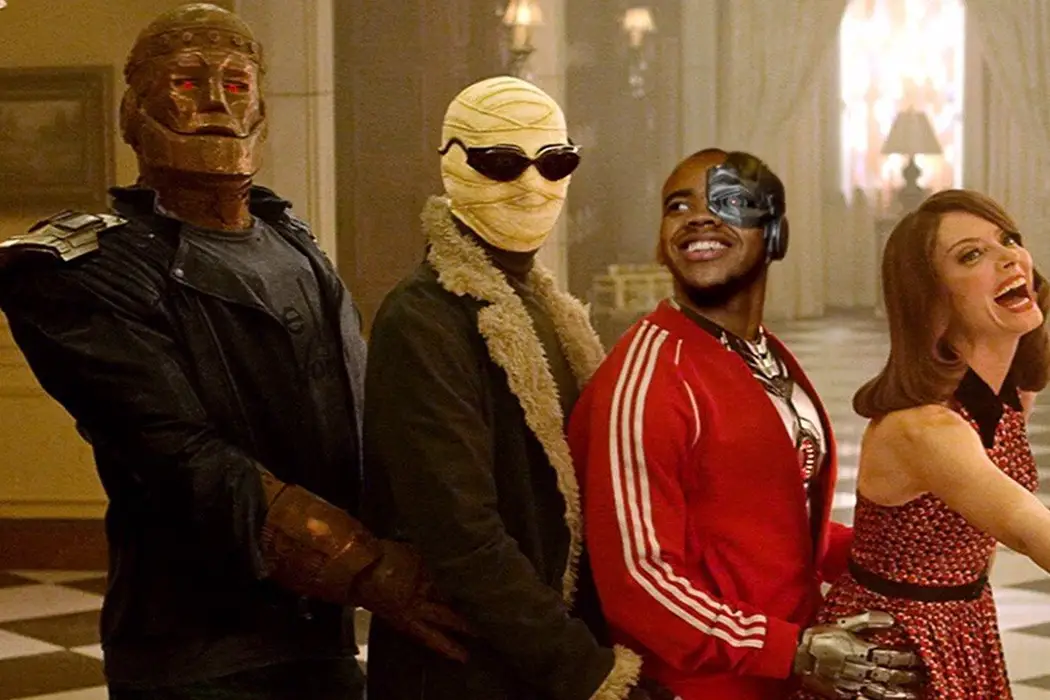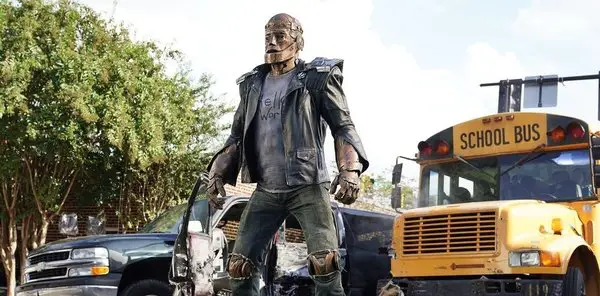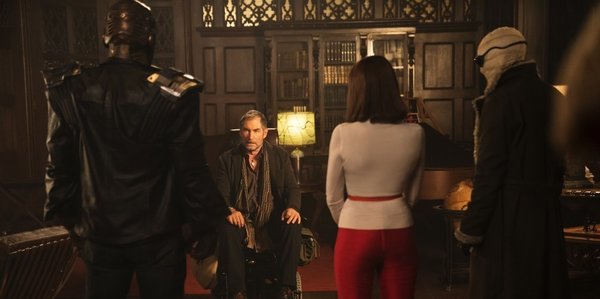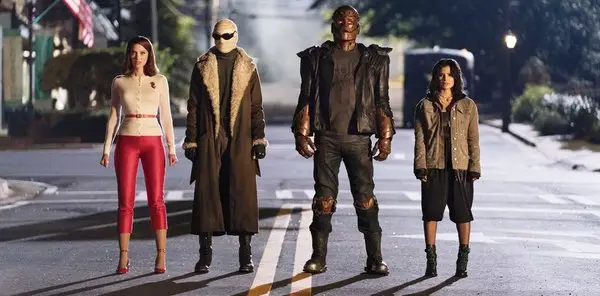DOOM PATROL S1E1: DC Has Finally Done It

Joseph Dominguez is a Southern Californian with a degree in…
Upon renaming the comic series My Greatest Adventure to The Doom Patrol in 1964, the team of protagonists were deemed “The World’s Strangest Heroes”, and Grant Morrison elevated this philosophy with his untamed, psychedelic comic run of the same name in 1989. In their most recent outing, DC’s latest television show, Doom Patrol, the team holds this tagline pridefully as the show takes its audience on an eccentric, unapologetic ride.
With Jeremy Carver (Supernatural, Being Human) behind the script and Glen Winter (Arrow, The Flash) directing, the experienced team of creators spare no time in letting the audience know that this will not be a typical superhero show, but it won’t be a typical show of misfit heroes, either. The television series transcends the overused superhero tropes by letting us in on the jokes without becoming a full-on satire, as Alan Tudyk’s fourth-wall breaking narration as Mr. Nobody opens with the line, “Ugh. More TV superheroes, just what the world needs.”
The Show Itself (Minor Spoilers Ahead)
The show opens by introducing Cliff Steele (Brendan Fraser), a former NASCAR driver who nearly loses his life in an automobile accident. After being found by Chief Niles Caulder (Timothy Dalton), Steele is brought back to life not as human, but as a consciousness within a welded body of metal—later known as Robotman (voiced by Fraser and physically portrayed by Riley Shanahan). Steele goes through rehabilitation in order to become in control of his new body and regain lost memories from before the accident. His road to recovery is accompanied by introductions to Larry Trainor/Negative Man (voiced and played in flashbacks by Matt Bomer, with Matthew Zuk portraying his costumed counterpart) and Rita Farr/Elasti-Woman (April Bowlby).

Larry Trainor was once an all-star Air Force Pilot before he flew through a cosmic anomaly and fell from the sky. Trainor survived the crash, but his body was left completely burned and he dons a full-suit of bandages because of it. Rita Farr was a self-absorbed B-list actress in the 50’s, and, after an accident, her body becomes uncontrollably malleable. The trio of misfits abide by Chief Caulder’s rules and live in isolation for years, until Crazy Jane (Diane Guerrero), a DID sufferer with 64 personalities (each of which has his or her own superpower), shows up at Caulder’s manor and convinces the team to go on a trip.
The four set out to adventure the town, and in doing so, they unintentionally cause mayhem and make themselves known to the evils of Chief Caulder’s past. After a short squabble regarding self-preservation and altruism, they ultimately bring it upon themselves to keep the city safe of any dangers that may be heading their way. This decision will bring about the team audiences will come to know as “The Doom Patrol”.
The Utterly Bizarre and How it Works
Their short-lived run on the Titans series was enough for executives at DC to create the spin-off, and after some rebranding and a recast, the show places the team in an even stranger limelight which surpasses their previous appearance.
The showrunners’ decision to be meta is reminiscent of Fox’s Deadpool, except with Doom Patrol, Tudyk’s eerie but comical self-awareness never feels like it outstays its welcome. The show rides on the coattails of fun and quirk, with its bright undertones and pleasantly outlandish performances, but beyond that the show is balanced by an engaging narrative as it delves into family dynamics and the idea of second chances.

Each member of the Doom Patrol is a broken image of their past selves, and although they hardly had a choice in becoming the uncanny team of heroes, their somber histories and eccentric personalities create a relatable dichotomy. The show doesn’t sell itself as a family drama with superheroes—which more and more superhero shows seem to be doing—but rather as an exciting coming-of-age tale with twists and drama along the way. This grounds the series enough to speak to audiences without burying them in the sea of overdone television heroes, as I found myself completely hypnotized in the tangle of these characters’ lives. The show’s unique take on the superhero genre makes for a captivating experience, and it could not have been done without its stellar cast.
Timothy Dalton’s portrayal as Chief Caulder reinvents the mad scientist first seen in Titans (then played by Bruno Bishir), and both Matt Bomer and April Bowlby fit right into place as their uniquely bizarre personas. I also found amusement in the show’s decision to use two actors, one to voice and the other to physically portray, for both Robotman (Fraser and Shanahan) and Negative Man (Bomer and Zuk), which made out to work exceptionally well. There is no single performance that falls short, as one would expect upon seeing the cast-list, but Fraser as Cliff Steele and Diane Guerrero as Crazy Jane offer the most notable performances, and their chemistry flourishes in every scene they share.
Robotman is arguably the most renowned character of the Doom Patrol, and Fraser finds his stride right out the gate and succeeds in making both his over-the-top and traumatized selves believable. His performance is matched by Guerro’s take on Crazy Jane, as she completely offers herself to the role of a woman with multiple personalities. Although Guerrero doesn’t reach the level of James McAvoy in Split, she adopts her personalities and makes each of her sporadic changes feel genuine, and I’m excited to see what her future performances will be.
The only real problem the show had was is in its visual effects. For the most part, the graphics worked. I particularly enjoyed them in Bomer’s flashback scenes, but they occasionally felt cartoony among Bowlby’s body transformation sequences. I can’t be too harsh, however, because I’m sure the CGI took a small hit solely based on the show’s budget, and, after all, it is a comic book series.
Doom Patrol: Conclusion
DC’s Doom Patrol isn’t the first television show to bring about a team of unconventional heroes—in fact, it isn’t even the only one to do so in February (Netflix released all 10 episodes of Umbrella Academy on the same day as Doom Patrol’s pilot), but Doom Patrol places itself among the best of them. Because it’s on a streaming service rather than television broadcast, Doom Patrol lacks the restrictions a show like CW’s The Flash has, but it doesn’t overuse explicit dialogue and graphic violence in a way shows like DC’s Titans or Netflix’s The Punisher do. It blends comedy and heart with super-heroism surprisingly well, as the episode is capped off by a battle thats sure to ensue and an inspirational-magic-fart produced by a donkey.

By not taking itself too seriously, DC’s Doom Patrol creates a whimsical world of super-heroics that is both fun to watch and easily digestible. The show is held together by a strong cast, an engaging script, and the strange, abstract source material it draws from. With fresh ideas already in motion and Joivan Wade set to debut as Cyborg in the coming episodes, Doom Patrol has plenty in store for DC fans and casual viewers alike.
What did you think of Doom Patrol? Will you be keeping up with the show?
The first episode is now streaming on the DC Universe streaming service, and episodes are slated to release every Friday.
Does content like this matter to you?
Become a Member and support film journalism. Unlock access to all of Film Inquiry`s great articles. Join a community of like-minded readers who are passionate about cinema - get access to our private members Network, give back to independent filmmakers, and more.
Joseph Dominguez is a Southern Californian with a degree in psychology and an immense love for pop culture.













